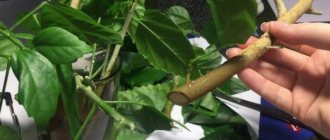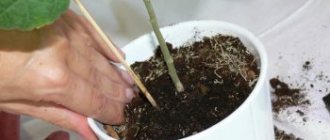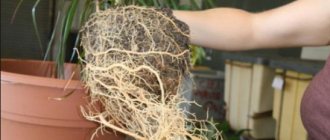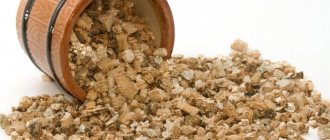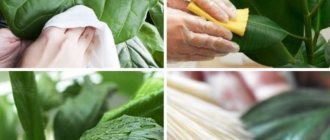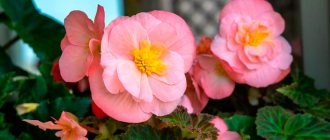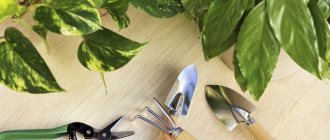Trimming potted vegetation is one of the aspects of caring for them. But this procedure is also very individual. Some flowers should not be touched at all, while others need to be cut regularly. Cutting off different parts of vegetation has its own purposes: removing yellowed leaves, dried shoots, creating a certain shape for the plant, promoting bushiness, or abundant flowering, or simply for the purpose of rejuvenation. Pruning is an integral part of the life of most flowers. This action is simple, but you should remember the approach to each individual type of vegetation and the general rules.
Pruning indoor plants
A little about myths.
The first and probably the most important myth: you can’t prune, because the flower will be “hurt” (or unwell). It is very difficult to refute this opinion, since people by their nature tend to humanize the world around them. But as we know, plants do not have a nervous system (like humans), and not a single serious study has shown that plants are capable of feeling anything. Therefore, they cannot “love”, “prefer”, etc. And besides, very often plants acquire an unattractive shape from improper care. Therefore, if you have a lopsided or elongated plant, which in your opinion “loves” the way you care for it, then perhaps you should read again about the recommended methods of care? The second myth is that if you cut off the growing point, then the plant will die. In fact, there are very few such plants. Now I can only remember the Arekov family. All other plants (dracaenas, yuccas, euphorbias, ficuses, etc., including orchids) can be pruned as you personally want. The third myth is that if you prune a plant, it will hurt. Anything that makes the crown unattractive can be cut off from almost any plant. It will not die or get sick from this. Naturally, subject to the necessary care. And I will write below about when and what to cut off.
Making the cut of green pets correctly
Before starting this procedure, it is necessary to study the preferences of each flower individually, and then act based on their preferences. Some species can die even from simply shortening the stem. Other specimens respond very well even to very frequent clippings. In addition to viewing information on potted crops, it is also necessary to inspect the flowers themselves, for damage, dead shoots, and whether growth and development are going well. All this will help determine what degree of pruning is required and to what extent.
It is necessary to study the preferences of each flower separately
Systematic circumcision will help simplify all care activities. Care must be taken to avoid the need for cuts. It is necessary to constantly regularly maintain decorativeness and ideal shape, to prevent overgrowth or, conversely, complete loss of foliage. All timely procedures can eliminate difficult pinching. Removal for sanitary purposes is carried out every year, during the period of active growth, and then as necessary, in order to maintain the vegetation in proper form. There is no need to carry out a rejuvenating haircut separately; this procedure is carried out together with other cleanings in an emergency or systematically.
In order to correctly carry out removal actions, you need to follow some rules that can also be correlated with the norms for garden vegetation. The general and main task is to take all necessary measures to maintain the health of flowers.
Basic norms for cutting potted crops:
- The tools you use to carry out the procedures must be well sharpened. There is no need to expose green pets to additional stress;
- When caring for pets, hygiene is important: clean hands, tools and surfaces. Disinfection of the instrument is required before proceeding with the removal of plant parts. In addition, you should be very careful when working with very sensitive flowers and with poisonous domestic specimens. Protect the skin of your hands, as well as the surfaces and protect the plants themselves;
- Plan to do separate pruning and replanting activities, although it is recommended for many plant varieties to do these activities together. But this should not be done, because the flower must adapt after transplantation in order to be ready for cutting. In fact, this is a lot of stress for all vegetation, it causes harm, so leave time for rest. There is no point in taking risks, because otherwise you will destroy the plant, and such sacrifices are not at all necessary;
- The cuts must be carried out correctly, they are done at an angle, above the level of the kidneys, remember this rule. If you decide to completely remove the stem, then this is done at the base, at ground level or at a branching point. A partial cut should be made above the bud by 3-7 mm. Carry out a careful examination of the buds, they will tell you how to correctly orient the growth of green pets - up or to the sides. There is also a rule that potted vegetation is pruned in such a way that new stems will begin to grow outward, and not inside the bush, which means that the cut should be made from the bud;
- There is no specific time period when it is necessary to cut a plant, for this you need to take into account many different factors, but the most important one is the individual needs of the individual specimen. In general, this procedure is carried out in the spring, or in the active stage of growth, since the upcoming summer period will allow it to gain strength after drastic changes. But this rule works, again, taking into account the age of the flower and the stage of its development.
- While cutting, stop periodically and look at the result from the outside. This activity is fun and can be overdone. Therefore, if you want to shape the crown of a flower, take a break, step away, evaluate where you need to cut and proceed to work further, but with breaks.
How to properly prune a houseplant. Some terms.
The growing point is the tip of the shoot. This is where new leaves grow from. A node is the place of the shoot to which the leaf is attached (or was previously attached if the leaf is no longer there). New branches can grow from nodes.
Nodes
Internode - the area of shoot between the nodes. No further growth is possible at this point. Pinching is the removal of a bud at the end of the shoot, i.e., the growth point.
Change the water more often
designmom.com
Some flowers grow even after they have been cut. For example, anemones continue to grow and consume enormous amounts of water every day.
Look at the hydrangeas in the picture above and you will notice that they have absorbed three-quarters of the water in the vase within 24 hours.
We are used to pouring tap water into a vase. There is nothing wrong with this, but if you want to extend the life of the flowers, then pour salt-free water into the vase. It can be obtained by passing tap water through a filter, which is found in almost every home today.
How to properly prune a houseplant. General rules.
The most optimal time for pruning is the beginning of the growth period, that is, the last days of February or all of March. Of course, you can trim at other times. But in summer the plant can bloom. Autumn is preparation for the rest period. A pruned plant can awaken its buds only in the spring. Accordingly, there is a risk that the flower will remain in the form of a “stump” for about six months. But in general, you can also prune in the fall. In winter, the plant should rest. Pruning in some cases encourages growth. Accordingly, natural rhythms are disrupted.
There are plants that, after pruning, easily form sloppy bushes. First of all, these are trees with a rosette growth form, for example, Schifflera, Dieffenbachia and the like. Although experienced gardeners are quite successful in pruning them, most often it is recommended to update such plants periodically. That is, cut the cuttings, root them, and grow new young plants. With this method, the old overgrown bush is thrown away. An alternative would be to trim it very short. In this case, you need to cut off almost the entire above-ground part of the flower, leaving a stump 3-5 cm in height. Then 1 or 2 new shoots grow from it. As a result, the plant will look young.
Types and timing of plant pruning
Pruning can have different purposes:
- Sanitary pruning is carried out on almost all indoor crops. It consists of removing damaged, dried or weakened parts of the bush. Their timely cutting allows you to save the flower from the development of diseases and stimulates its overall tone. The need for sanitary pruning is judged by the condition of the plant. From some bushes it will be enough to occasionally remove old dry or yellow leaves, from others - withered inflorescences or shoots stretched out and knocked out of their crowns. Old shoots that have stopped developing can only draw nutrients onto themselves, interfering with the growth of young shoots, so they are also often removed.
- Shortening young shoots , as well as pinching , helps to maintain the beautiful shape of the crown, as well as better tillering of the branches. Often, removing the top growth point helps activate side shoots, making the bush more luxuriant. An increase in the number of branches in many crops often leads to an increase in the number of flowers. Typically, young stems are shortened in actively developing plants that are capable of growing green mass in a short time. Such pruning is carried out at the stage of their growth, if necessary, shortening the branches to the optimal length. Pinching involves removing only the very top of the shoot - above the first pair of leaves. It can be carefully plucked off with your fingers or cut with small scissors.
- Rejuvenating pruning promotes the growth of fresh branches. Aging bushes that have begun to lose their former attractiveness, as well as plants that have survived the winter, need it. Lack of light and other conditions unsuitable for flowers during this period often lead to elongation of shoots or a slowdown in the growth rate of bushes, so proper rejuvenation can activate their internal resources. In addition, many flowering species form buds only on young shoots, so without regular pruning they will not be able to fully bloom.
- Formative pruning is designed to give the bush the desired shape without damaging it. It is usually carried out in the spring, with the beginning of active growth of shoots. In this case, the shoots can be shortened by no more than a third. You should not carry out such pruning “by eye” - it is better to think in advance which shape will best suit a particular plant. The tops of the shoots should be removed symmetrically so that the bush does not turn out one-sided. Before formative pruning, sanitary pruning is always carried out, first of all removing damaged or dead parts of the bush. It can also be combined with rejuvenating - shortening old shoots will also contribute to the attractiveness of the plant.
What branches can be cut off?
Pruning is done to ensure that the crown is beautiful in the future. Very often, flower growers prune so that it is beautiful “here and now.” At the same time, they do not pay attention to where the kidneys are directed. This approach leads to the fact that after a month the plant loses its decorative qualities. Therefore, before pruning, decide what exactly you want to get in the end. It is quite possible that it will be enough for you to thin out the bush a little or cut off an overgrown shoot. Notice the branches that grow parallel to each other. Almost always this makes the crown not beautiful. Depending on the situation, one of these branches can be cut off to the base, or cut off near a bud that “looks” in the other direction. Naturally, you decide what to do. In addition, branches that grow inside the crown or are directed in a direction different from the growth of most other shoots (up or down) make the bush unattractive. They also need to be either cut off altogether or trimmed to a bud pointing in the right direction. That is, in accordance with your personal understanding of future development and aesthetic taste.
Parallel shoots
The shoot grows upward, thereby making the bush sloppy
Trimming to form the crown of indoor flowers
Shaping is used to refine all perennial varieties of bushes and trees, which with the help of this manipulation are given a compact, strict or sophisticated appearance. If thickness or maintenance of the desired size is necessary, sticking to the shape is the goal, the direction of which you choose based on personal preference.
During formative circumcision, several tasks are performed at once:
- activation for the growth of young and outer stems;
- stimulation of abundant flowering;
- adjustment of height and shape, removal of excessively long, unproductive branches and few leaves;
- giving a certain shape to the crown, maintaining decorativeness and attractiveness;
- independently giving the deciduous mass a strict shape: ball, square, pyramid and others;
- adjustment of large potted flowers;
- sticking to one specific silhouette;
- giving vegetation density and lushness.
All these care activities are aimed at maintaining the health of potted crops and giving them an individual style that matches the taste of the owners and their interior.
Care measures are aimed at maintaining the health of potted crops.
It is optimal to carry out formative cutting with the arrival of spring, when the first signs of vegetation vegetation appear, or after it, when the stage of complete dormancy begins. For crops with a flowering period, this method is carried out after flowering. Removing all spent peduncles, yellowed and dried parts of flowers, thereby creating the necessary volume, size and silhouette, activating the growth of stems that will give lush color next season. But we need to take the natural needs of plants as a basis:
- if flowering occurs on young stems, then pruning should be done at the beginning of the growing season;
- if the vegetation produces flowering on the branches of the previous season, no shaping is carried out, the flower stalks are cut off to the first leaves;
- Decaying flowers need to be regularly rejuvenated by cutting after flowering.
Formation of a bush-like crown in Ficus Benjamin. Personal experience.
If you have read my previous articles, you will probably recognize my ficus) Its crown has grown in one plane. There are branches whose growth direction makes the bush ugly. In addition, it was originally planned (if you remember) that the plant would be a compact tree. Ficus benjamina is a wonderful, unpretentious plant on which you can practice pruning. Even if you cut off a branch, and later see that it was a wrong decision, you can always correct it.
Which flowers in a vase should not be trimmed: analysis of the nuances
From the recommendations of florists it is clear that trimming flowers in a vase is important and it is recommended not to ignore this rule. However, reviews show that not all buds need such manipulations. First of all, there is no need to trim flowers that were presented in a hat box and bouquets in a basket, since the buds in such compositions are installed in special platforms soaked in a nutrient solution.
If you decide to order fresh inflorescences with fairly thin stems (lilies of the valley, snowdrops, etc.), it is also not recommended to regularly trim the stems. Florists give identical recommendations for wildflowers. When ordering bouquets and floral arrangements in the Flower Empire online store (Kazakhstan), you will always receive fresh, correctly decorated and trimmed inflorescences, delivery of which is possible both in Astana (Nur-Sultan) and in other regions of the country.
Trimming.
First, I will prune the branches whose growth direction is contrary to the general rules. I don’t want to cut them out completely, just half them. After all, I plan that the bush will be more or less voluminous, and not, as it is now, in one plane. Since I don't want the plant to grow excessively upward, I cut off the top. In addition, there are parallel branches. In this way I will get rid of this shortcoming. Now let's examine the bush from all sides and determine what else will interfere with the formation of a beautiful bush. After that, I will trim the branches that, in my opinion, have excess growth. This is what happened in the end.
When is the best time to do this?
The optimal time for pruning is considered to be the period between the dormant period and the beginning of active growing season, as well as the time after flowering has completed.
Reference . It is not recommended to combine the procedure of removing shoots with replanting a plant, as this can significantly slow down the development of new shoots.
Never prune plants haphazardly , be sure to read the recommendations for a particular species, since you may achieve not an improvement in their appearance, but a temporary stop in flowering or uncontrolled growth.
Which moon can be manipulated?
The moon plays a huge role in the life of living organisms on Earth. During pruning, green crops invariably receive injuries in the form of damage to sprouts. To minimize the damage caused, the removal procedure should be carried out in accordance with a calendar developed based on the phases and cycles of our natural satellite.
Carry out pruning on the waning moon , but not at a time when it is under the sign of Sagittarius, since there is a high probability of injury to the plants.
Favorable days according to the lunar calendar
The most favorable lunar days in 2022:
- May – 29, 30;
- June – 1, 2, 28, 30;
- July – 1, 5, 8, 19, 31;
- August – 4, 7, 24, 25, 29;
- September – 3, 6, 22, 29, 30;
- October – 1, 5, 21, 27, 31;
- November – 1, 3, 4, 22, 28;
- December – 1, 2, 21, 25, 29.
Trimming result.
My ficus has sprouted many new shoots and grown a fair amount of foliage. Pruning and subsequent correction of the crown using pinching made it possible to ultimately obtain a voluminous, compact and beautiful plant. That is, all the tasks that stood before me were solved. Now it is necessary to periodically adjust the crown by pinching and (possibly) pruning. Similarly, you can form the crown of any other plant. After all, they all develop in a similar way.
Good luck to you and your plants!
Subscribe to our channel on Telegram
Pinching (pinching)
Restraining types of pruning are the simplest. Both pinching (a popular synonym for pinching) and shortening are measures that are carried out throughout the entire active growth stage in order to prevent excessive elongation of branches, stimulate the growth of lateral branches or improve the quality of flowering. In fact, all these terms are synonymous and we are talking about a very simple procedure - removing the tip of the shoot or excess buds. These are mini-trimmings, the easiest measures to shape and contain plants.
Pinching, or pinching, involves removing the upper growth point, the upper pair of leaves or the upper segment of the stems of cacti and succulents. Thus, after flowering, separating 1-2 segments of each Schlumbergera stem allows you to achieve more abundant flowering in the next season, and pinching the tops of young plants allows you to get denser bushes. Buds are plucked mainly from large-flowered indoor plants. Excess buds, formed in large quantities, deteriorate the quality of individual flowers, so timely removal of the ovaries allows you to achieve the most spectacular spectacle.
Tweezing has several tasks:
- By removing the apical growth point, they stimulate the growth of new lateral and productive shoots.
- A simple procedure that does not require injury to the shoots or special knowledge thickens the crown.
- The plant is not allowed to stretch out and is stimulated to grow in all directions.
Shortening shoots is somewhat different from pinching. In this case, not only the apical bud is removed, but also all excess or excessively elongated upper part of the shoot. By removing a third or half of the length of the branches, the plant is not allowed to stretch, growth is promptly restrained and its compact size is maintained. Shortening is most often used on indoor vines.
Pruning a houseplant
What is the state of the Moon now?
Detailed information about the phase of the moon today: what is the moon like now?
| Household moon phase: | Full moon |
| Today's lunar day: | 14 |
| Exact age of the moon: | 13 days, 6 hours and 59 minutes |
| Moon visibility: | 98% |
| Beginning of the current lunar cycle (new moon): | June 10, 2022 at 1:54 pm |
Interesting materials:
When is 5 working days? In six months, how many days of vacation? In how many days will Maslenitsa be? How many days does it take to respond to an application? How many days does it take to get paid after dismissal? How many days after can you take a vacation? How many days later can I issue an invoice? After how many days do maternity benefits accrue? How many days is the new moon in? After how many days should bed linen be changed?
What about roses?
There is a lot of controversy and disagreement about pruning roses. If this is done, then only after the onset of persistent cold weather. But most experts still recommend not pruning roses in the fall. This is explained by the fact that any pruning stimulates the active growth of shoots in roses. And in the autumn, this is no longer necessary, since they will not have time to ripen and are guaranteed to freeze at the first frost.
But the plant, instead of preparing for winter, spends energy on new shoots. As a result, they will be weakened and may not survive the winter. For the same reason, the last flowers should not be cut off. But it is highly advisable to remove leaves from rose bushes, since they can become carriers of diseases and wintering grounds for pests.
The question of how to prune perennials is a very difficult one and the answer depends on the characteristics and characteristics of each specific plant. The main thing is to observe moderation in everything. This will not only allow you to do the correct pruning, but also do it in a timely manner, which is very important for the good growth and development of perennials. When starting pruning, you need to remember that each plant requires an individual approach.
